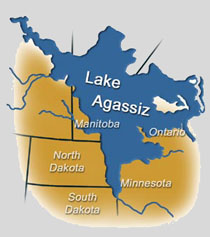Fargo Before Settlement
Before Humanity

Fargo is located on the Red River of the North on the eastern boundary of North Dakota. The river is formed by the confluence of the Bois de Sioux and Otter Tail rivers at the twin cities of Wahpeton (N.D.) and Breckenridge (Minn.). It flows northward, for 440 miles forming the North Dakota-Minnesota border, before entering Manitoba and emptying into Lake Winnipeg after a course of 545 miles. The Red River Valley is the youngest major landscape in the contiguous United States. Over the past two million years, continental glaciers repeatedly advanced southward across eastern North Dakota, depositing thick blankets of glacial sediments. Around 12,000 years ago, as the last ice sheet began to retreat from North Dakota, what is now the Red River Valley became part of an immense glacial lake, Lake Agassiz. About 9,300 years ago, the waters of Lake Agassiz drained away from the region, leaving behind clay-rich sediments that for thousands of years would be occupied by prairie grasslands. The result today is a rich, black soil that make the Red River Valley one of the most fertile farming regions in the world.
Before Europeans

Prior to Euro-American settlement of the Northern Plains in the 19th Century, the land had been occupied for many centuries by indigenous peoples. Archeological investigations document the presence of big game hunting cultures after the retreat of the continental glaciers about 10,000 years ago and later settlements of both hunting and gathering and farming peoples dating ca. 2000 B.C., to 1860. When the first white explorers arrived, distinct Native American groups existed in what is now North Dakota. These included the Dakota or Lakota nation, Assiniboine, Cheyenne, Mandan, Hidatsa and Arikara. Groups of Chippewa moved into the northern Red River Valley around 1800, and Cree, Blackfeet and Crow frequented the western buffalo ranges.
Eastern North Dakota becomes part of the United States
In what has been called the greatest real estate deal in history, the United States in 1803 paid $15 million to France (ruled by Emperor Napoleon Bonaparte) for its Louisiana Territory. The Louisiana Purchase --828,000 square miles of land west of the Mississippi River stretching from the Mississippi River to the Rocky Mountains and from the Gulf of Mexico to the Canadian border-- nearly doubled the size of the United States, making it one of the largest nations in the world. Most of North Dakota was included in the purchase, but not Fargo and Eastern North Dakota. The Treaty of Paris signed on September 3, 1783, by Great Britain and the United States concluded the American Revolution and established a boundary between Canada and the United States. Unfortunately, the treaty negotiators used a map that depicted the source of the Mississippi as considerably north of its actual location. As a result, the area that is now Eastern North Dakota and Western Minnesota remained in dispute. The dispute was settled with the Convention of 1818 Between the United States and Great Britain. This agreement fixed the 49th parallel as the border between the United States and Canada from Lake of the Woods westward to the Rocky Mountains, with joint occupation of the Oregon Territory. This treaty ceded what is now part of Minnesota and North Dakota to the USA.
The First Europeans
With several notable exceptions, contact between the Native peoples and American traders, explorers and military personnel in the Northern Plains remained peaceful during the early 19th Century. Native Americans became instrumental in the fur trade; major trading posts at Fort Union and Fort Clark, and others of lesser significance, catered mainly to Native trappers and hunters. In exchange for their meat and furs, the Native Americans received guns, metal tools, cloth and beads and other trade goods. This exchange forever altered Indian cultures and it often brought dangers; in 1837, for example, smallpox virtually wiped out the Mandan people at Fort Clark. For the most part, the incursion of Euro-Americans into the Northern Plains caused few confrontations with Native American peoples. In 1863, 1864 and 1865, however, the pattern changed. Major military expeditions searched the Northern Plains for Santee Dakota who had participated in a violent uprising in Minnesota in 1862. Battles at Whitestone Hill in 1863 and at Killdeer Mountain and in the Badlands in 1864 diminished Dakota resistance, forcing many onto reservations to avoid starvation. A chain of military outposts, beginning with Fort Abercrombie in 1857, continually increased federal power, and great slaughter of the northern bison herds after 1870 eventually caused the nomadic tribes to submit. Some bands of Dakota resisted into the 1880s, but their old way of life on the plains was lost.
Dakota Territory, Cass County, and Fargo
On March 2, 1861, the Congress of the United States created the Dakota Territory, which consisted of the present-day states of North Dakota and South Dakota, and most of Montana and Wyoming. The name was taken from that of the Dakota Indians. Cass County was organized in 1873, with Fargo designated as the County Seat. However, Fargo was not officially organized for two years. On January 5, 1875, the Dakota Legislature enacted "An Act to Incorporate the City of Fargo." The city's first election was held on April 5, 1875, with 137 voters. George Egbert was chosen mayor and six aldermen were elected. They first met as the city government April 12, 1875. In 1876, six hundred persons lived in Fargo.
Statehood
As early as 1871 the legislature of Dakota Territory had requested Congress to divide the Territory, and in 1874 Moses Armstrong, while in Congress, had petitioned that the northern part be made into a new Territory named Pembina. Nearly every year a petition was sent to Congress praying for admission as two states. In 1880 it was suggested that the northern part be called North Dakota. However, if Armstrong had won the day, you would be living in Fargo, Pembina instead of Fargo, North Dakota. On November 2, 1889, President Benjamin Harrison approved the admission of North Dakota to the United States.
